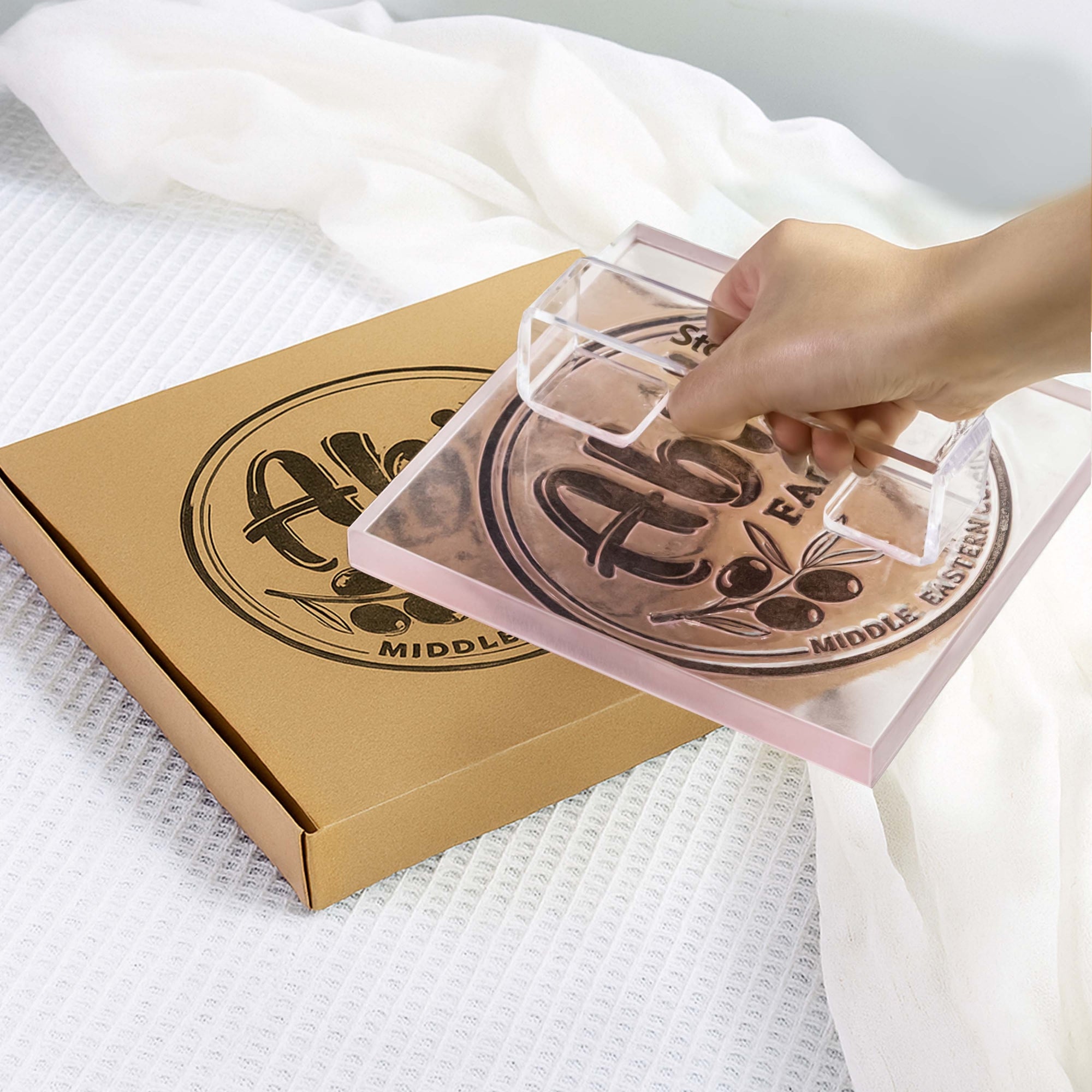북 엠보싱은 상상력과 정교한 장인정신이 만나는 곳입니다. 이 틈새 예술 분야에서 숙련된 창작자들은 뛰어난 기술력과 자유로운 창의력을 결합하여 책 표지에 문학적 이야기를 물리적으로 새겨 넣습니다. 평범한 표면을 특별한 3차원 태피스트리로 탈바꿈시키기 위해서는 정교한 기술과 예술적 비전이 모두 필요합니다.
왜 정도 에 대한 사항 책 엠보싱
책 엠보싱은 놀라운 제어력과 정밀함을 요구합니다. 선명하고 입체적인 인상을 얻으려면 압력, 온도, 타이밍이라는 세 가지 핵심 요소의 균형을 정확하게 맞춰야 합니다. 압력이 너무 높으면 디자인이 변형되거나 늘어질 수 있고, 너무 낮으면 선명한 인상을 남기지 못합니다. 가죽, 종이, 직물은 모두 다르게 반응하기 때문에 각 소재에 맞춰 온도를 정밀하게 조절해야 합니다. 정확한 타이밍 또한 매우 중요합니다. 너무 오래 가열하면 과도하게 구워져 소재가 타거나 뻣뻣해질 위험이 있고, 너무 적게 가열하면 덜 구워져 얕게 인쇄됩니다.
엠보싱 장인들에게 이러한 엄격한 숙련도는 예술적 비전을 꽃피울 수 있게 해줍니다. 단순한 텍스트나 테두리로 시작했던 것이 이제는 정교하고 섬세한 비유적 장면과 상징적인 구성으로 진화했습니다. 한때 종이 위에만 국한되었던 이미지가 이제 생생하고 질감 있는 차원으로 솟아올라, 책 표지 그 자체에 문학적 서사를 물리적으로 구현합니다.

피해야 할 일반적인 실수
그러나 야심찬 엠보서들이 점점 더 정교한 디자인으로 기준을 높이는 동안 그들은 다음과 같은 잠재적인 함정에 직면하게 됩니다.
- 압력이 일정하지 않으면 인상이 고르지 않게 될 수 있으며, 깊은 부분과 거의 양각되지 않은 부분이 함께 생길 수 있습니다.
- 정렬이 잘못된 엠보싱 다이, 플레이트 또는 스탬프는 구성의 원활한 흐름을 보기 흉하게 방해합니다.
- 온도 설정이 적절하지 않으면 재료가 타서 흔적이 남거나, 아무리 압력을 가해도 재료가 완전히 굳어지지 않을 수 있습니다.
- 복잡하고 여러 겹으로 된 디자인의 경우, 엠보싱 요소의 순서를 잘못 배치하면 전체 레이아웃이 정렬되지 않을 수 있습니다.
숙련된 엠보서라도 복잡한 프로젝트에서 약간의 계산 오류는 오랜 시간 공들여 작업한 결과물을 금세 망칠 수 있습니다. 이러한 함정을 피하려면 집중력, 경험, 그리고 창의적인 문제 해결 능력이 필요합니다.
엠보싱 소재: 알아야 할 모든 것
성공적인 엠보서들은 각 소재의 특성이 다르기 때문에 맞춤형 접근 방식이 필요하다는 것을 잘 알고 있습니다. 가죽, 종이 또는 원단의 고유한 특성에 적응하려면 다음 사항을 고려하세요.
- 가죽:가죽은 유연하며 엠보싱 작업 중에 늘어날 수 있습니다. 변형을 방지하려면 다른 소재보다 약간 낮은 압력과 온도를 사용하세요. 다음과 같이 실험해 보세요. 다양한 등급의 가죽 귀하의 디자인에 가장 적합한 것을 찾아보세요.
- 종이:종이는 섬유질이 많아 습기를 흡수하여 엠보싱 특성에 영향을 줄 수 있습니다. 종이에 다음 사항이 있는지 확인하세요. 적절한 수분 함량 최상의 결과를 얻으려면 (보통 8~12%). 가죽보다 더 높은 압력과 더 낮은 온도를 사용하면 선명한 인상을 얻을 수 있습니다.
- 구조:원단의 직조 구조 때문에 일관된 인상을 얻기 어려울 수 있습니다. 늘어남을 방지하고 압력을 고르게 분산시키려면 안정제나 뒷면 소재를 사용하세요. 원단의 두께와 구성에 따라 온도와 압력을 조절하세요.
어떤 소재로 작업하든, 스크랩 조각에 테스트 엠보싱을 하여 다양한 세팅에 어떻게 반응하는지 확인하세요. 이를 통해 기법을 미세하게 조정하고 최종 제품에 발생할 수 있는 문제를 방지할 수 있습니다.
예상치 못한 실수를 만났을 때 해야 할 일
가장 눈길을 끄는 엠보싱 책 표지 중 일부는 예상치 못한 것을 받아들이는 이러한 즉흥적인 사고방식에서 탄생합니다. 숙련된 엠보서는 정렬이 어긋나거나 고르지 않은 인쇄 자국을 실수로 보기보다는, 의도적인 예술적 표현의 기회로 여깁니다.
예를 들어:
- 약간 비스듬히 찍힌 디자인 테두리는 활기찬 비대칭성을 더할 수 있습니다.
- 너무 깊은 인상이 있는 부분은 대담한 질감의 요소가 됩니다.
- 섬유의 불일치로 인해 재료가 엠보싱을 잘 견디지 못하는 섹션은 추상적인 질감 콜라주로 기념됩니다.
마스터 엠보서는 열린 마음으로 계획되지 않은 홈, 주름, 그리고 솟아오른 가장자리를 단점이 아닌 시각적으로 이야기를 풀어낼 수 있는 가능성으로 바라봅니다. 그들은 원래의 컨셉을 유기적인 엠보싱 공정과 조화를 이루는 창의적인 솔루션으로 유연하게 변형합니다.
즉흥적으로 상황을 처리하고 우연을 활용하는 능력 덕분에 평범한 책 표지를 예술적 의도가 가득한, 독특한 걸작으로 탈바꿈시킬 수 있습니다.
책 엠보서 스탬프의 디자인을 사용자 정의할 수 있나요?
예, 다음과 같은 많은 공급자가 있습니다.
-
StamPrints 맞춤형 고양이와 별이 빛나는 하늘 책 엠보서:책 더미 위에 앉아 별이 빛나는 하늘과 달을 바라보는 사랑스러운 고양이가 그려진 매혹적인 엠보서입니다. 책을 사랑하는 사람, 교육 기관, 사무실 등 어디에나 잘 어울리는 디자인으로, 독특함과 세련미를 동시에 선사합니다. -
StamPrints 맞춤형 식물책 엠보서:이 엠보서는 생기 넘치는 식물로 장식된 책을 돋보이게 하며, 좋아하는 명언이나 메시지를 텍스트에 새겨 넣을 수 있습니다. 문학과 자연의 관계를 기념하며, 각 책을 특별한 예술 작품으로 탈바꿈시킵니다.
두 엠보서 모두 황동과 스테인리스 스틸로 제작되었으며, 크기는 100 x 100mm이고 황동판 직경은 42mm입니다. 디자인 방향은 고정되어 있지만, 주문 시 원하는 방향을 지정하실 수 있습니다.
와 함께

실용적인 고려 사항
- 책 페이지 엠보서는 기술적으로는 모든 페이지에 사용할 수 있지만, 제본이 손상되는 것을 방지하기 위해 첫 번째나 마지막 페이지에 사용하는 것이 좋습니다.
- 책 엠보서 스탬프 다양한 책 크기에 적용할 수 있는 다용도 스탬프이지만, 최적의 결과를 얻으려면 호환되는 스탬프 크기를 선택하는 것이 중요합니다.
- 엠보서는 하드커버와 페이퍼백 모두에 사용할 수 있습니다. 하드커버는 튼튼한 바닥을 제공하는 반면, 페이퍼백은 과도한 압입을 방지하기 위해 더 세심한 주의가 필요합니다.
실험적 정신과 입증된 기술을 고수하는 것, 그리고 창의적인 응용에 대한 열린 마음을 균형 있게 유지함으로써, 고급 엠보서라면 의도적인 예술성이 가득한 아방가르드 책 표지 이야기를 꾸준히 제작할 수 있습니다.
엠보싱 마스터리 - 정밀함과 자유로운 창의성이 만나는 곳
북 엠보싱은 섬세한 기법과 자유로운 예술적 표현이 조화를 이루는 예술입니다. 이 기술을 익히면 책 표지는 감각을 사로잡고 상상력을 자극하는 특별한 경험을 선사할 것입니다.모든 질감과 윤곽은 독자를 독특한 여행으로 안내하며, 정밀한 기술과 가장 대담한 비전을 현실로 구현하는 용기를 결합했을 때 창의성이 어떻게 빛나는지 보여줍니다.






